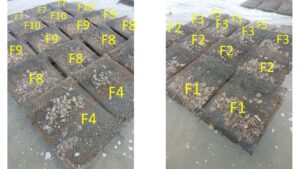Final report for FW18-041
Project Information
The Ostreid Herpesvirus is a highly lethal virus and is the most imminent threat to the survival of the U.S.
Shellfish industry. One variant (OsHV-1µVar) of this virus has devastated Pacific Oyster culture
industries in Australia, Europe and New Zealand. Other commercial species of bivalves are vulnerable in
varying degrees. The U.S. variant OSHV-1 is so far only present in Tomales Bay (CA) and adjacent areas
but is only slightly less damaging. Up to 90% of juvenile oysters can be lost each year and cumulative
losses can be up to 35% through the growout stage. Although research is being conducted to develop OsHV-1 resistant strains, this research is slow and takes at least 2-3 generations to develop partial resistance and potentially millions of dollars. The three oyster companies involved in this proposal (Goose Point Oyster Co., Hog Island Oyster Co. and the Willapa Bay Fish and Oyster Co.) proposed to test a more rapid screening method to determine whether individual oyster broodstock possess some degree of resistance and thus begin to form the basis of broodstock pools to be used in an emergency situation if the virus spreads outside of Tomales
Bay. The Hog Island Oyster Co. can make immediate use of this since they have considerable losses
annually due to this disease. This method is based on using individual pair spawns, cryopreservation of
sperm and the warm Hawai`i conditions to reduce generation time. Nine families were created, then tested for resistance by outplanting half of each family in Tomales Bay to expose them to the virus. Half of each family was retained at the Hawaii hatcheries for future use in breeding. Of the nine families, one family demonstrated a very high level of resistance (87% survival) and several others varied between 40-50%. Thus,
developing resistant Pacific Oysters for commercial production can be jumped started ahead of an
emergency, rather than waiting 8-10 years for more traditional approaches to succeed.
The overall of objective is to test a new, rapid and less costly screening method to assess the
degree of disease resistance in individual broodstock oysters. These individual oysters will form
the core of a new breeding population which could essentially save the industry if a disease
outbreak occurs. We view this as an urgent and emergency measure.
Objective 1: Use individual pair spawns to produce a limited number of families to be screened
for disease resistance to OsHV-1 at Tomales Bay, CA. The parents (F0) of progeny (F1) that
show any degree of resistance will then be used in a variety of crosses to reinforce resistance.
Objective 2: Continue to develop cryogenic methods as an additional and valuable tool for
selective breeding and other uses, both practical and for research.
Training for hatchery staff, farm managers and for aquaculture students was also an important component of this work although in the original proposal we did not include this as an objective.
Cooperators
- - Technical Advisor (Educator and Researcher)
- (Researcher)
- (Researcher)
Research
Our overall goal was to test a method to allow shellfish hatchery operators and farmers to screen individual oysters for resistance to the Ostreid Herpesvirus (OsHV-1). This disease is the most imminent threat to the West Coast and Hawaii shellfish farming industry. Most industry stakeholders believe it is a question of when, not if, this disease spreads beyond its current range in the U.S. (Tomales Bay, CA area). Other strains of this virus have devastated oyster farming industries in other regions such as Australia and France. The most common approach in other countries to developing OsHV-resistant oysters is to use survivors of disease outbreaks to create future generations. This is not possible in the U.S. since the major oyster hatcheries are located in areas there the OsHV-1 is not present. It would not be possible nor advisable to bring oysters that survived outbreaks back to the hatcheries as this could spread the disease to new areas.
Our hypothesis was that it would be possible to screen individual oysters to determine if they carried the genes for resistance by conducting pair crosses, then exposing half of the progeny to the disease in Tomales Bay, CA. The broodstock oysters and half of each family's spat (juvenile oysters) would remain at the hatchery for future use in case any individuals or families demonstrated some degree of resistance. We estimated that eight families were the maximum number we could care for and monitor with the grant funds of $25,000. This work tends to be expensive since the larvae period is around 4 weeks, the juveniles then require 1-3 months to reach the size to outplant to the farm, then they must be cared for and monitored on the farm until they show signs of being exposed (i.e. by dying). Raising larvae and spat requires a high level of daily care and feeding.
Spawning and rearing of the larvae and spat followed standard hatchery procedures. Spawning of the oysters was done through thermostimulation (i.e. increasing water temperature). Each broodstock oyster was kept in an individual container during the spawning so that fertilization can be controlled. Each male that spawned was crossed with eggs from two females each. Once eggs are fertilized, the progeny from each crosses were kept in individual 400 liter tanks for about three weeks. They were fed daily with a diet of mixed microalgae species. Tanks were drained and cleaned every other day. The larval development period is around three weeks. When larvae develop an eye-spot and a foot, they are transferred to downweller silos where they undergo metamorphosis and set on shell chips. The setting on shell chips produces single oysters. The resulting spat continued to be fed with microalgae and cleaned regularly until they were around 6 mm in length. When approximately 1000 of each family reached this size, they were shipped to the Hog Island Oyster Company in Tomales Bay, California. The families were deployed in mesh bags at an area that usually suffers a high rate of mortality from OsHV-1. The families were inspected frequently in order to detect the onset of mortality. The period of exposure was from June through October 2018. When dead oysters began to appear, tissue was collected from recently dead or dying oysters. Samples were then tested for the presence of the OsHV-1 virus using PCR to validate that exposure to the virus had occurred. Final results were obtained in late October, 2018.
The broodstock used in this research were retained at the PACRC. Each oyster was permanently labeled and held under the best possible conditions so they can be used in the future if their progeny have some degree of resistance. Half of the progeny from each cross was also retained at the hatchery.
We will also attempt to build on the work conducted under the auspices of a prior WSARE grant to use cryopreservation techniques to preserve sperm from resistant oysters. This will be done in spring 2019 when the F1 families are sexually mature.
We used 45 large Pacific Oysters (Crassostra gigas) from the Goose Point Oyster farm located in Willapa Bay, WA, to create 10 families. The source of the oysters was from selected strains from the OSU MBP which has been conducting selective breeding for improved growth and performance for over 25 years. A limited number of oysters from the same source had been tested by Dr. Colleen Burge in Tomales Bay, and several cohorts demonstrated resistance to one or more microvariants of the Ostreid Herpesvirus, but in the range of 30-40% survival. Goose Point Oyster Co. had provided oysters to Dr. Burge in 2017 for testing. These were taken from farm stock that was produced by the MBP. Thus these represented the typical farm stock that most NW oyster farms use. The MBP had not begun work on disease resistance at this point.
The broodstock oysters were large specimens that were 2-3 years old (Figure 1). All were conditioned in the Hawaiian Shellfish hatchery in Ke`eau, Hawaii. Spawning was induced by thermostimulation on May 2-3. Each oyster was placed in a clear plastic bowl. As each oyster began to spawn, it was sexed and labeled. It was planned that the sperm from each of four males would be used to fertilized the eggs from two females for each male. Thus eight females would have been used. We ended up using five males and ten females as there were extra oysters that spawned and we wished to create one extra pair in case some died as larvae or spat (which is common in oyster hatcheries). One of families from the "extra" crosses (Male 5 crossed with Female 11) suffered from 100% mortality. We thus had nine families to test.
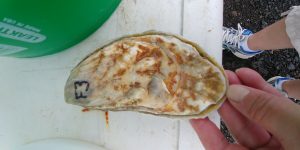
This design allows for identification of which parent(s) is responsible for any disease resistance. For example, if the half-sib progeny of one male parent show differences in resistance, that additional degree of resistance would then be attributed to the female parents. The genetic basis of inheritance of disease resistance is not known, only that the trait appears to have a fairly high degree of heritibility.
One of the families was lost in the larval period, leaving nine families (one more than originally planned). Each of the broodstock oysters used for breeding was labeled and kept for future use. The progeny oysters began setting at around 30 days post-fertilization and were set on shell chips in downweller systems (Figure 2). After the larvae have set, the water flow through the silo is reversed so it becomes an upweller.
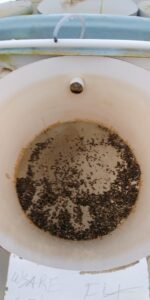
The setting period was rather prolonged, taking over a week to set all families. Any larvae which had not set at this point were discarded. The spat also grew at different rates which provides additional information on the differential performance between families.
We aimed at sending 1,000 6 mm spat from each family to the Hog Island farm for the exposure challenges. This size was chosen since smaller spat are more vulnerable to OsHV-1, but very small spat (e.g. 2-3 mm) are more labor intensive to monitor and maintain. The number of 1000 spat per family was also judged to be the largest amount that could be handled without additional costs. The first set of families was shipped on July 25, 2018 (Figure 3). Not all families had 1000 6 mm spat at that time, so others were shipped as the critical number and size were reached. The water temperature was still relatively low in July (15 degrees C), which is below the temperature (25 degrees C) at which outbreaks of OsHV-1 tend to occur.
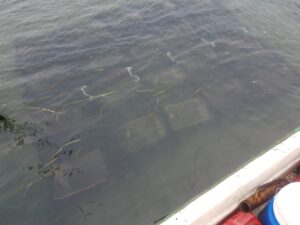
The Hog Island Oyster Co. staff monitored the oysters frequently as it was important to be able to detect the onset of a disease outbreak immediately so that tissue samples of recently dead or dying oysters can be collected for testing. The Ostreid Herpesvirus can strike suddenly and can kill oysters within a few days. It is important to test the tissue for the presence of the OsHV-1 virus to validate results. Oysters can die for many reasons and moreover, the experience of the Hog Island Oyster Co. has been that outbreaks can occur in an extremely patchy fashion so that one small portion of a large bed of oysters can be affected while an adjacent spot might not be. In order to have a high level of confidence that surviving oysters are resistant, not just unexposed, PCR is use to test for the presence of the virus in oyster tissues. Dr. Jim Moore of the California Shellfish Health Laboratory had kindly offer to conduct the testing without charge. He confirmed that the virus was detected in the tissue of all families, thus indicating that survivors are most likely resistant.
The location used for the exposure challenges is a leased area on the Hog Island Oyster Company farm where outbreaks of OsHV-1 are most severe. This location is also being used by other researchers to test their strains. In early August, mortalities were first observed in oysters from the Molluscan Broodstock Program (MBP) at Oregon State University. Although the UHH oysters were located adjacent and close to the MBP oysters, similar mortalities were not observed in the UHH oysters. This caused some concern because outbreaks of this disease are often patchy, killing oysters in certain locations on a farm, but leaving nearby oysters alive. On September 5, massive mortality in some UHH families was reported. One family had >90% mortality, while other families appeared to be unaffected.
Oysters continued to die over the next 6 weeks. The final monitoring was conducted on Oct. 24, 2018. The cumulative mortality is shown in Table 1. Note that the following are half-sib families: F1/F2, F3/F4, F7/F8 and F9/F10. F5 did not have a half-sib family as F6 was lost during the larval period. These results are interesting and useful for a number of reasons. Firstly, F5 had a survival rate of 86.9%. Since the corresponding half-sib family was lost, it is not possible to determine which parent was responsible for the resistant genes, but given the high survival, it is likely that both parents contributed. In the case of F3 and F4, quite different results were obtained for the two families (45.3% and 93.7%, respectively), which suggests that the female parent for F4 most likely did not carry resistant genes. A similar phenomena can be seen for F7 and F8.
Table 1. Mortality of Pacific Oyster spat after exposure to OsHV-1. Crosses in which the progeny demonstrated no more than 60% mortality are in bold font. These will be used in 2019 to produce new families that will then be tested at Tomales Bay.
| Family | Cross | Mortality (%) |
| 1 | Male 1 x Female 1 | 46.8 |
| 2 | Male 1 x Female 2 | 59.8 |
| 3 | Male 2 x Female 3 | 45.3 |
| 4 | Male 2 x Female 4 | 93.7 |
| 5 | Male 5 x Female 11 | 13.1 |
| 7 | Male 3 x Female 7 | 89.8 |
| 8 | Male 3 x Female 8 | 65.3 |
| 9 | Male 4 x Female 9 | 78.6 |
| 10 | Male 4 x Female 10 | 85.2 |
We thus have six broodstock oysters out of the original 15 used that can be utilized for 2019 production. These would be Males 1 and 5 and Females 1, 2, 3 and 11. Male 2 died, so it cannot be used. A cut-off point of 60% mortality was used to select the oysters that are considered to be at least partially resistant. This is somewhat arbitrary, but is based on the the experiences of the Hog Island farm where it is common to lose 70% or more of young spat to OsHV-1. Assuming that future trials validate that these individual do carry the gene(s) for disease resistance, the fact that nearly 50% of the total number of broodstock produced families with some degree of resistance indicates that this method of screening is relatively effective in identifying resistant broodstock more rapidly than standard methods would allow. Only two individual oysters, however, appears to have produced highly resistant progeny (Male 5 and Female 11). This represents 12% of the total numbers tested. Clearly this is a low number, but since there are at least 1,000 of the highly resistant progeny to utilize for breeding, this is a good start towards developing a large enough pool of highly resistant broodstock for use in the future.
Hatcheries use slightly different strategies to create and maintain limited numbers of oysters to maintain broodstock lines, versus crosses used to produce large numbers of seed for farming. The Hawaiian Shellfish LLC hatchery uses only around 300 individual broodstock oysters annually, hence broodstock pools can be relatively small in number, as long as inbreeding is avoided as much as possible. The three hundred broodstock oysters are sufficient to produce billions of larvae and millions of spat for distribution to about forty farms on the West Coast. Thus, assuming the next crosses using Male 5, Female 11 and their progeny are also highly resistant, this offers the promise of potentially being able to produce sufficient spat for the Hog Island farm and at least three other farms in the affected region by 2020. Additionally, any number of seed that exceeds the demands of these four farms can be distributed to the other 36 farms that are customers of the Hawaiian Shellfish hatchery. This will help these farms in case the OsHV-1 spreads outside its current range.
We hope to be able to resume this process of testing individual broodstock and their progeny in the Spring 2019 production season.
To complete the objectives of this research, some of the resistant spat will be used to contribute sperm to be cryogenetically preserved to be used in the future.
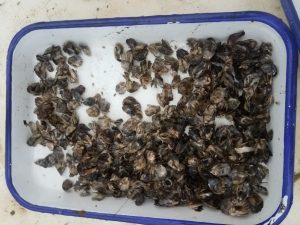
The end date for the project was 6/30/2019. The spat continued to be tracked until August 2019. Mortality was minimal after the juveniles reached adult size, but differences in appearances, size and the variability of size continued throughout the grow out period (Figure 5). This is useful information as there are commercial traits which are valuable other than the degree of disease resistance.
Figure 5. Oyster families in Tomales Bay showing the differences in adult oyster size and appearance. This photograph was taken in March, 2019.
The results of this research are important in that this method offers a much quicker way for hatchery operators and farms to begin building pools of broodstock over time in an affordable manner. Our team will continue working with other researchers, as well as the OSU MBP program to accelerate this process in whatever manner possible.
Research Outcomes
Education and Outreach
Participation Summary:
The main outreach target is hatchery and farm staff, and undergraduate students who are intending to undertake aquaculture as a career.
Twelve undergraduate students received training as described above. Two of the students were subsequently hired by Hawaiian Shellfish LLC in professional jobs. Eight hatchery professionals were also trained in Hawaii. Four farm personnel were trained in California. At least one hundred students (K-12) were included in this work.
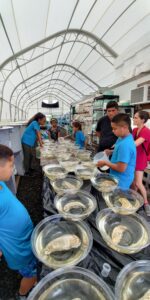
Education and Outreach Outcomes
Although the method we proposed to test was theoretically simple, it required a considerable amount of coordination between three teams (Hawaiian Shellfish, Goose Point Oyster, Hog Island Oyster and the PACRC) and about 20 professionals. The collaboration went well, however, in part due to a longer term partnership between the various entities.
We also found this to be a valuable exercise for the purposes of building capacity within our respective teams since each production stage must be accomplished at the highest level of competency. We did a considerable amount of cross-training to be sure all team members were able to execute each component of the work.
This was also a very valuable educational opportunity for undergraduate students as they were able to obtain experience in nearly all stages of hatchery and nursery production, as well as learn more about genetics, breeding, biosecurity and pathology.
Farm management
Data collection and statistical analysis
Animal husbandry
Hatchery production
Selective breeding
Aquaculture genetics
